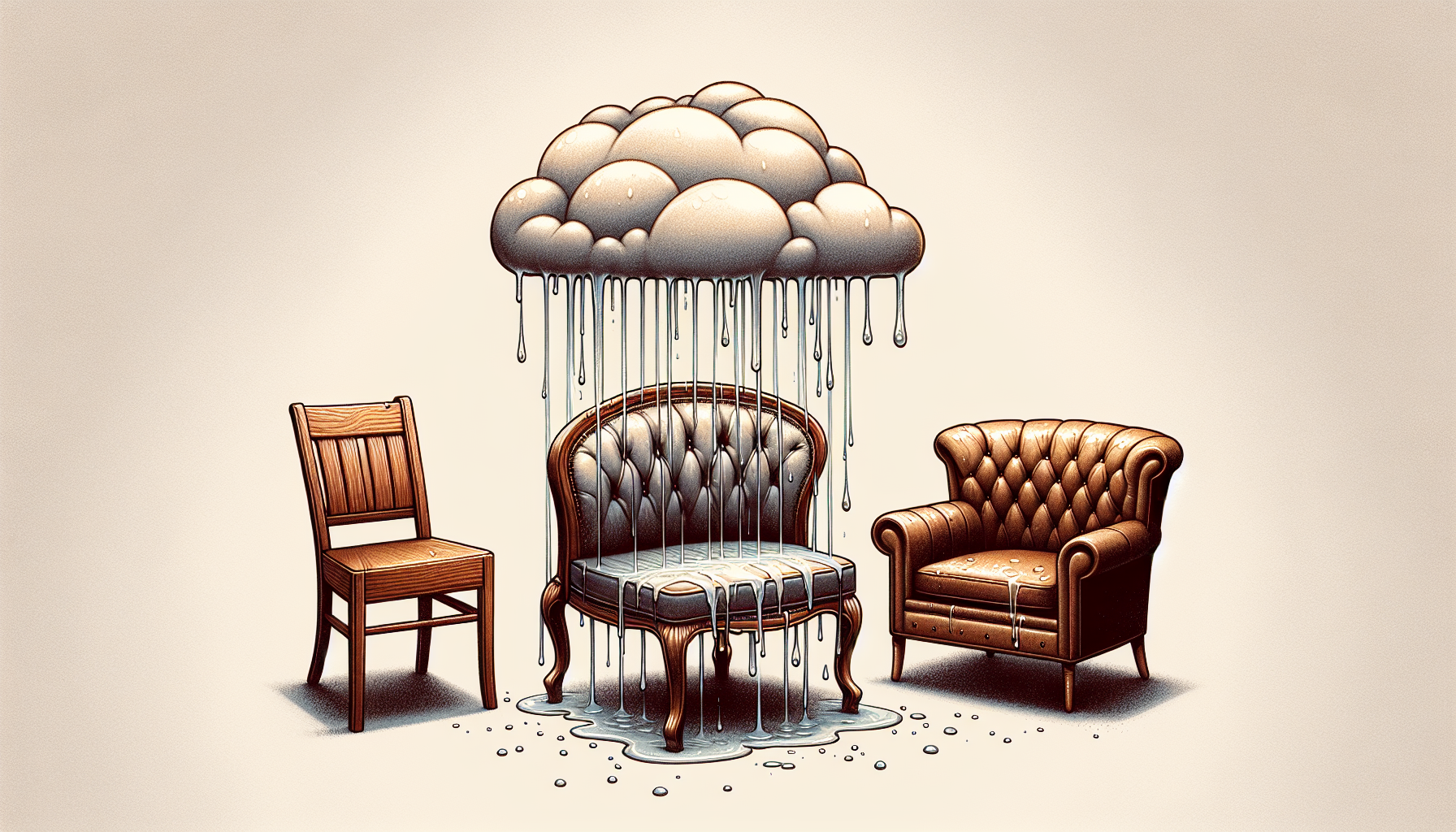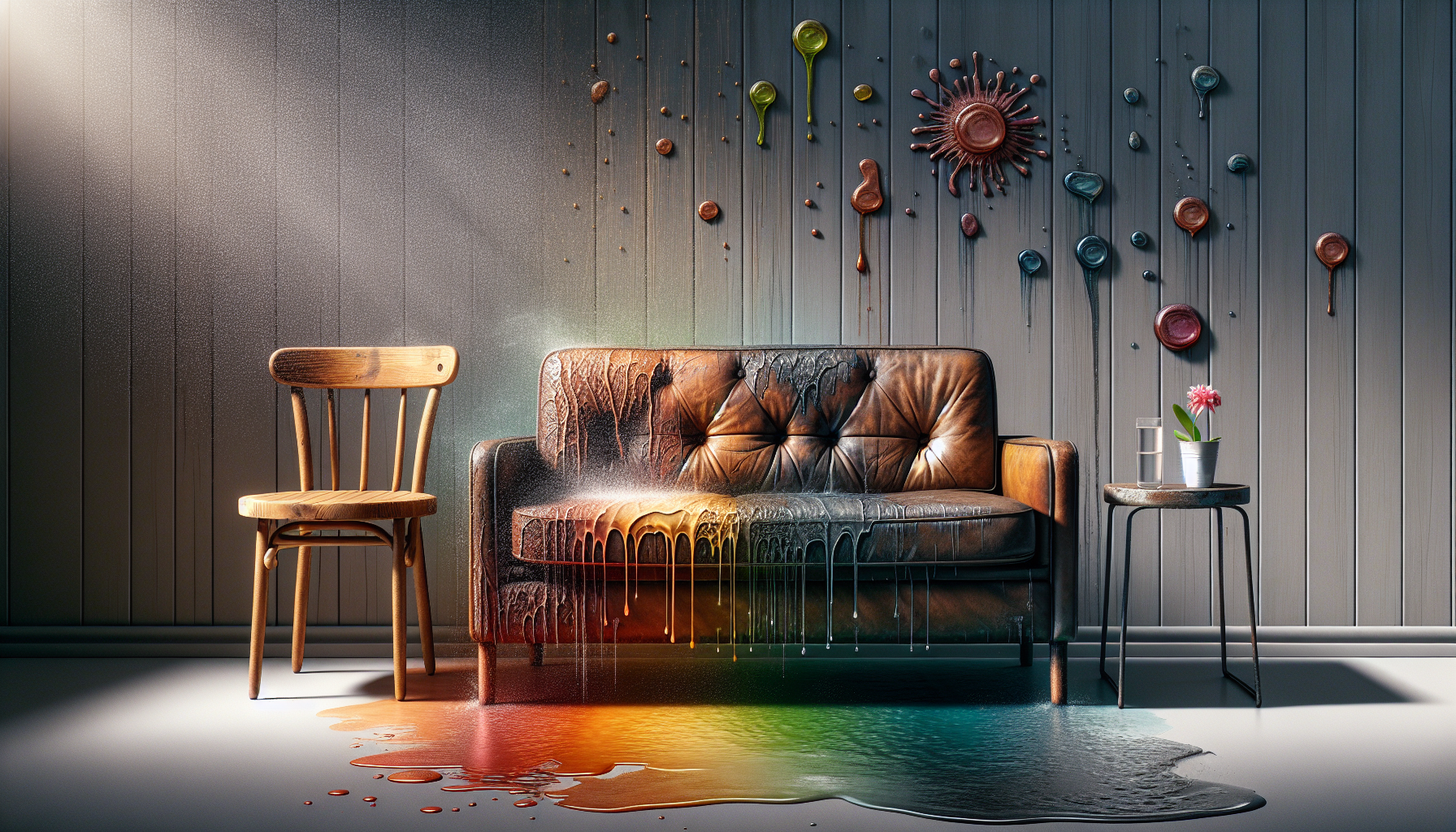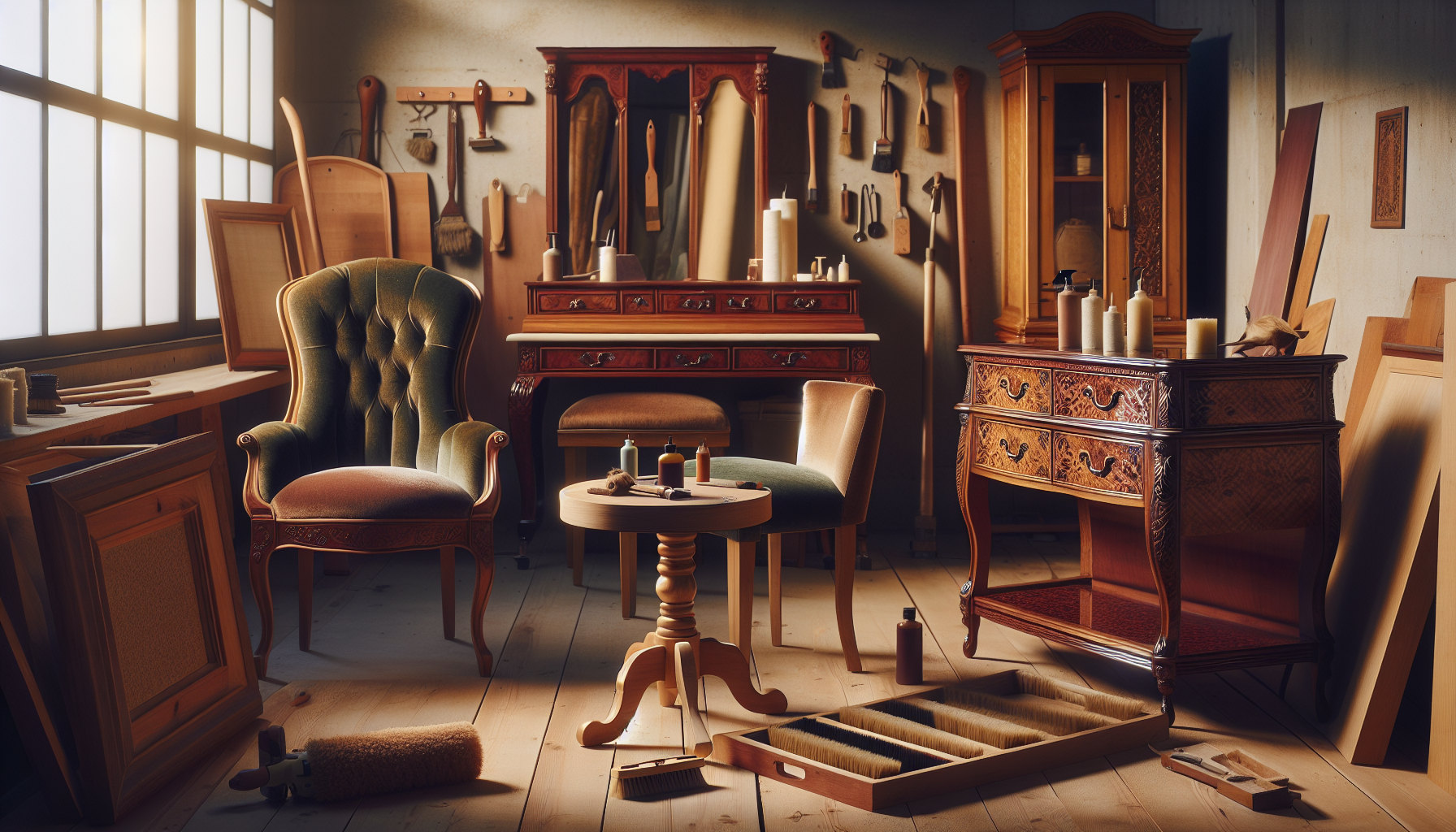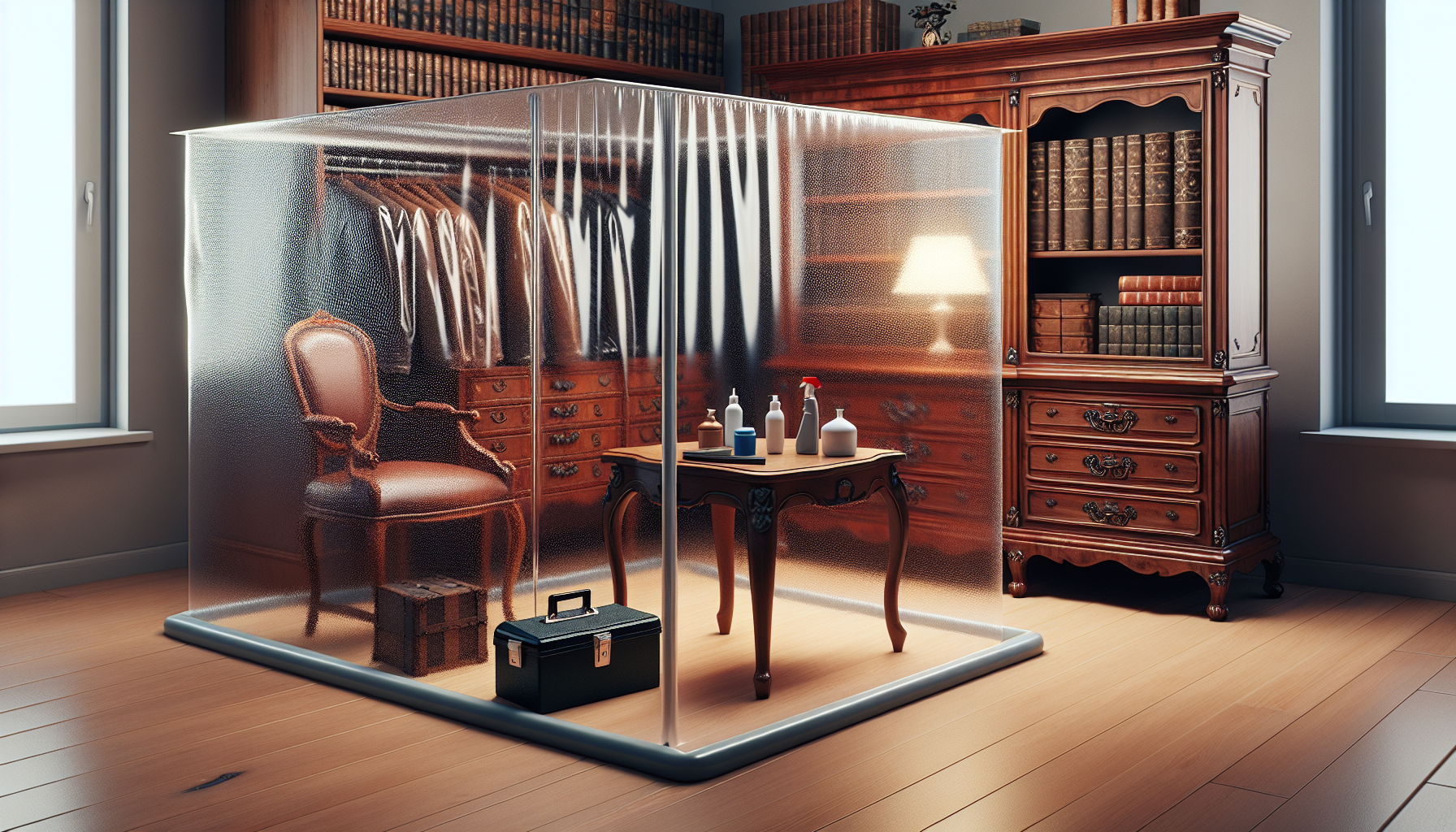If you’re panicked wondering how long furniture can sit in water before being ruined, you’re in the right place for answers. Immediate action can make all the difference, with various materials and water types influencing just how much time your furniture may withstand submersion. This article gives you the critical timeframe insights for wooden, upholstered, and leather furniture, so you can act swiftly to mitigate the water havoc.
Key Takeaways
-
Prolonged water exposure causes different types of damage to wood, upholstered, and leather furniture, including swelling, warping, mold, discoloration, and loss of structural integrity.
-
The severity of water damage to furniture is determined by the duration of exposure, type of water (clean, gray, or black), and furniture material—with wood and upholstery being especially vulnerable.
-
Effective restoration of water-damaged furniture varies by type and may involve drying, cleaning, and conditioning, but prevention through regular maintenance, sealing, and correct storage is key to minimizing future damage.
The Impact of Water on Different Types of Furniture

Picture your home, and all the furniture that makes it uniquely yours. It’s hard to imagine that something as harmless as water could transform your cherished pieces into heavily damaged wood furniture or a breeding ground for mold. But here’s the thing, the damage water can inflict varies significantly depending on the type of furniture.
We’ll examine the impact of water on various types of furniture such as wood, upholstered, and leather.
Wood Furniture
Wood furniture has a timeless allure. However, when exposed to water, the beauty of your wood table or chair can quickly fade as the furniture swells, warps, and even rots. Ever noticed how a wooden door doesn’t close properly after a heavy rainstorm? That’s because wood absorbs moisture and expands. Now imagine your solid wood furniture sitting in water for a long period. It’s like a sponge, taking in water until it’s saturated, leading to swelling and distortion of its structure.
The type of water your furniture encounters also plays a significant role. For instance, a flood or water event, such as flood water, can have a devastating impact, leading to:
-
Moisture absorption
-
Surface staining
-
Swelling
-
Susceptibility to mold and rot
Therefore, swift action is necessary when your wood furniture comes into contact with water, as time is a critical factor.
Upholstered Furniture
Upholstered furniture is often the centerpiece of a room, providing comfort and aesthetic appeal. However, when it comes to water exposure, these pieces can quickly turn from a source of relaxation to a cause of stress. The moment water comes into contact with upholstered furniture, it seeps into the fabric and padding, potentially leading to staining, watermarking, and even accumulation of mud and debris in the case of a flood.
If the furniture remains damp for a prolonged period, it becomes a petri dish for mold and bacteria, which pose significant health risks, including respiratory problems and allergies. The type of fabric also matters, as water exposure can cause:
-
Discoloration
-
Stiffness, especially in leather upholstery
-
Stripping of natural furniture oil in leather, contributing to stiffness and brittleness
-
Movement of dyes, affecting the appearance
Leather Furniture
Leather furniture adds a touch of luxury to any space, but when exposed to water, it can undergo some less-than-luxurious changes. Just like your skin, leather needs oils to stay supple and healthy. However, when leather furniture gets wet, these oils bond with water molecules and are drawn out as the water evaporates.
Furthermore, repeated exposure to water can lead to discoloration and stiffness. Mold can also develop, leading to further discoloration and deterioration, potentially compromising the integrity and aesthetic of the furniture. Prompt action is necessary to limit water exposure and prevent permanent damage to your leather items.
Factors Influencing Furniture Damage

Having understood the impact of water on different furniture types, we’ll now explore the factors that dictate the severity of this damage. Think of it as a triad: the duration of exposure, the type of water, and the furniture material. These three factors combine in different ways to determine whether your wet furniture will be left lightly stained or heavily damaged.
Duration of Exposure
The first component of the triad is the duration of exposure. It’s like soaking in a hot tub – the longer you stay, the more pruney your fingers get. Similarly, the longer your furniture sits in water, the more damage it sustains. Mildew and mold can start developing within the first two hours to seven days of exposure to water.
For instance, if your wood furniture is submerged for a day, it can start to swell and crack, leading to swollen wood furniture. After prolonged water exposure, it can even rot, leading to a loss of the piece. Similarly, upholstered furniture can deteriorate rapidly if submerged for an extended period, reaching a point where it becomes impossible to salvage.
Type of Water
The second component of the triad is the type of water. Not all water is created equal, especially when it comes to furniture damage. There are three types of water to consider:
-
Clean water, such as that from a broken supply line, typically poses the least risk.
-
Gray water, which contains some contaminants, can lead to more serious damage.
-
Black water, which is heavily contaminated, often with sewage, can cause the most serious damage, including mold growth and structural weakening.
Imagine spilling a cup of clean water on your couch – it’s a nuisance but not a disaster. Now imagine if that water was from a sewage backup. The situation just got a whole lot messier and more damaging. Therefore, it’s crucial to consider the type of water when dealing with wet furniture.
Furniture Material
The third and final component of the triad is the furniture material. Different materials react differently to water. For instance, wood is prone to rotting, weakening, and warping when exposed to water, potentially becoming irreparable.
Upholstered furniture tends to absorb more moisture, making it more susceptible to water damage and mold growth. However, leather and vinyl upholstery are generally more resistant and may withstand water exposure better than fabric-based upholstery. So, the material of your furniture plays a crucial role in determining its susceptibility to water damage.
Salvaging Wet Furniture: What Can Be Saved?

After understanding the effect of water on various furniture types and the factors that determine the extent of damage, we’ll now concentrate on the subsequent step – rescuing damp furniture. It’s like a triage situation; you need to assess the damage, determine whether repair or replacement is the best option, and then take appropriate action.
Assessing Damage
Before you can begin salvaging your wet furniture, you first need to assess the damage. It’s like a doctor examining a patient – you need to identify all the pieces that have been impacted and closely examine them for any signs of damage.
Water damage in wood furniture can be identified by water stains, warping, cracking, mold, or rotting. Upholstered furniture shows water damage through mold or mildew on the fabric and saturation that hampers cleaning and drying. Leather furniture may exhibit signs of warping, spotting, staining, swelling, or mold formation.
Armed with this knowledge from your insurance company, you can make an informed decision on the next steps to take.
Repair vs. Replace
Once you’ve assessed the damage, you’re faced with a crucial decision – to repair or to replace? It’s like deciding whether to fix your old, trusty car or buy a new one. The decision is influenced by the materials the furniture is made of and the degree of water damage it has sustained.
Replacing water damaged furniture may be more cost-effective if the labor costs are high or if specialized technicians are required. Additionally, if the damage is extensive, such as a broken frame or torn upholstery, replacement may be the more cost-effective option.
However, sometimes, the sentimental value of a piece may justify the extra cost of repair, even if it’s not the most economical choice.
Drying and Restoration Techniques

Having covered damage assessment and the decision-making between repair and replacement, we’ll now explore drying and restoration methods for various furniture types. Remember, the most effective methods vary depending on whether you’re dealing with wood, upholstered, or leather furniture.
Wood Furniture Restoration
Restoring wood furniture is a multi-step process that begins with drying. This involves removing moisture by allowing the furniture to air dry in a well-ventilated area and utilizing fans or dehumidifiers to expedite the process.
Once the furniture is dry, sanding is the next step. Coarse grit sandpaper is recommended for sanding water-damaged wood furniture. After sanding, wood filler is applied to any gaps or cracks using a filler that matches the wood’s color.
Employing suitable methods and a bit of patience can restore your lightly stained wood furniture, especially when dealing with water-damaged wood furniture, to its original condition.
Upholstered Furniture Restoration
When it comes to upholstered furniture, professional cleaning may be required. This involves washing with a chlorine bleach solution or spraying with a phenol product, in addition to removing stains and general dirt accumulation professionally.
Drying is also a crucial step in the restoration process. Air movers are utilized to quickly eliminate water residues from the surface of water-damaged upholstered furniture, while dehumidifiers aid in extracting moisture from the air, thereby stabilizing the drying process. However, if the furniture has been submerged for an extended period or the soaking has penetrated thoroughly, upholstery replacement may be necessary.
Leather Furniture Restoration
With leather furniture, the restoration process begins by drying. It’s crucial to carefully remove any standing water and allow the wet leather to air dry until it is slightly damp, but not fully dry.
Once the furniture is dry, mold can be removed using the following steps:
-
Create a mixture of mild detergent or leather saddle soap with warm water.
-
Apply the mixture to the affected areas and gently scrub with a soft cloth or sponge.
-
Rinse the area with clean water and dry thoroughly.
-
Finally, apply a leather conditioner to preserve the leather’s suppleness and prevent any potential cracking.
Following these steps can help bring your water-damaged leather furniture back to life, maintaining its elegance for years ahead.
Preventing Future Water Damage

Just as maintaining a healthy lifestyle requires consistent right choices, so does preventing water damage. In the case of furniture, these choices involve using waterproof coatings and sealants, proper storage and placement of furniture, and regular maintenance.
Waterproof Coatings and Sealants
Waterproof coatings and sealants offer protection against the damaging effects of water. They have the following benefits:
-
Anti-microbial properties
-
Prevent algal/fungal growth
-
Low VOC
-
Non-toxic
-
Protect against moisture
-
Enhance waterproofing abilities
-
Augment beauty
-
Protect the wood
Some recommended waterproof coatings for wood furniture include gloss finish polyurethane, varnish, and lacquer. As for sealants, Spar urethane, Thompson’s WaterSeal Multi-Surface Waterproofer Stain, Raincoat Clear Water-Based Water Repellent Sealer, clear gloss polyurethane finish, Thompson’s Water Seal, polyurethane sealant, and Premium Grade Wood Sealer Clear Silane Siloxane Penetrating Water Repellent are all excellent choices.
Proper Storage and Placement
Proper storage and placement of furniture can also go a long way in preventing water damage. For instance, furniture should not be placed in low-lying areas, basements, or near windows or doors that are prone to water leakage, as these are considered flood-prone areas in a home.
Another good practice is to:
-
Elevate furniture on blocks or platform beds to raise them off the ground
-
Use water-resistant materials in such areas
-
Lay down thick plastic sheeting on the floor
-
Clean the furniture before storage
-
Use furniture covers or drop cloths to protect against moisture
These are all recommended storage practices.
Regular Maintenance
Regular maintenance is the last piece of the puzzle in preventing water damage to furniture. It’s like a regular health check-up – you need to routinely:
-
Check for leaks and fix them promptly
-
Ensure good ventilation to avoid moisture accumulation
-
Use dehumidifiers in humid climates to maintain optimal indoor humidity levels
By following these steps, you can protect your furniture from moisture-related damage, as the ability to save wet furniture depends on your timely actions and proper care.
Signs of potential water issues during furniture maintenance checks may include:
-
A musty or moldy smell
-
Discolored paint that is peeling, bubbling, or flaking
-
The presence of water rings
-
Signs of small hairline cracks or a larger, spiderwebbed pattern of cracks
-
Any visible mold growth
Summary
In conclusion, understanding how long your furniture can sit in water before it’s ruined is crucial in preventing significant damage and preserving your cherished pieces. From the type of furniture to the duration and type of water exposure, various factors determine the extent of damage. Armed with the knowledge of these factors and the right restoration techniques, you can take proactive steps to salvage your furniture or take preventative measures to protect it from future water damage. Remember, when it comes to water damage, prevention is always better than cure.
Frequently Asked Questions
Is furniture ruined if it gets wet?
If your furniture gets damp and stays wet for a long time, it can be harmful and cause damage to the wood, but a brief exposure to water won’t ruin it.
How long does it take for water to damage wood furniture?
Water can start damaging wood furniture within 10 days of exposure to water. Be proactive in addressing water leaks to prevent rotting in your wood furniture.
How long does it take for water to damage foundation?
Water damage can gradually weaken a foundation over months or even years, starting with small cracks and allowing in small amounts of water, which can eventually lead to significant damage.
Can water damaged furniture be restored?
Yes, water damaged furniture can be restored through proper restoration techniques, although it may not be fully restored to its original condition. With attention and care, both wood and upholstered furniture can be repaired.
What to do after flood?
After a flood, it is important to prioritize safety by avoiding flood waters, disaster areas, and damaged structures. Stay informed and follow guidance from authorities before returning home or offering assistance.



